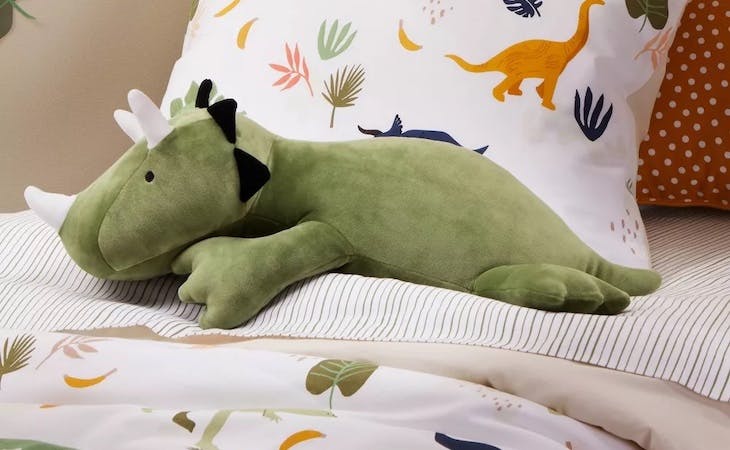We’ve been hearing about weighted blankets and weighted eye masks for some time now, so it only makes sense that weighted stuffed animals would be the next item in this category to become a trend. The thinking is these weighted products can help promote a sense of calm that makes it easier to fall (and stay) asleep.
The most popular weighted stuffed animal of the moment seems to be the TikTok-viral dinosaur, which has a pellet-filled belly that makes it the—in my opinion—perfect weight of about three pounds.
Think weighted stuffed animals are just for kids? Think again. It turns out they can be a healthy addition to anyone’s sleep routine, no matter your age. (Here’s what you need to know about sleeping with a stuffed animal as an adult.)
Here’s everything you need to know about weighted stuffed animals and whether they can help you sleep better.
What is a weighted stuffed animal?
Weighted stuffed animals are similar to weighted blankets. They’re products that are filled with beads or pellets and are thought to use deep pressure to calm the nervous system and release serotonin and dopamine throughout the body.
Think of a weighted stuffed animal like a weighted blanket in a smaller form. While weighted blankets usually range in weight from 10 to 20 pounds, weighted stuffed animals are usually in the one- to five-pound range. Most weighted stuffed animals clock in at around three pounds.
Benefits of weighted stuffed animals
There’s limited research on weighted blankets—and there’s even less research on weighted stuffed animals. But what we do know is that studies suggest applying pressure to the body in the form of a weighted blanket or stuffed animal can help reduce the body’s release of cortisol, the stress hormone.
It can also help calm the fight-or-flight response in the body and calm the nervous system, which is needed to usher in sleep. While weighted stuffed animals or weighted blankets aren’t a one-size-fits-all cure for everyone, they may be able to help those dealing with anxiety.
Weighted stuffed animals “provide pressure that most people find calming and relaxing, similar to a hug or a massage,” explains Lynelle Schneeberg, PsyD, author of Become Your Child’s Sleep Coach: The Bedtime Doctor’s 5-Step Guide, Ages 3-10.
While they have a similar effect as weighted blankets, they cover less of the body—so some people might opt for using a blanket instead of a stuffed animal or toy, she adds. (Learn about weighted pillows and whether they can help you sleep better.)
Weighted stuffed animal review
I purchased the popular weighted dinosaur, which weighs three pounds, and found that it unexpectedly helped reduce my anxiety while watching TV.
Recently, I’ve gotten into the routine of watching a show and then also scrolling on my phone (a no-no before bed) at the same time. With a weighted stuffed animal, you can cuddle with it or sleep with it on a part of you, such as your arm or stomach, says Schneeberg.
At night, I found that I liked cuddling with it better. Holding a weighted stuffed animal stopped my urge to pick up my phone while I lounged on the couch.
“You can also, of course, sleep on top of it, adds Schneeberg. “If you do, you may find that the material used to weight the stuffed animal can be adjusted to conform to your head and neck in a way that some people might find very comfortable.”
How to choose a weighted stuffed animal
There are many types of weighted stuffed animals on the market. So, I’d encourage you to think about what comforts you best so you can find the most relaxing option. Here are a few factors to keep in mind:
- Weight: I didn’t see many weighted stuffed animal options over three pounds, but I think I could have gone for a heavier one if it existed. A smaller child might want a stuffed animal that weighs even less.
- Size: Adults can choose whatever size they find soothing, But for a child, “parents would need to make sure that a child can carry, move, and manage a weighted stuffed animal completely independently and be able to retrieve it and put it back into their bed just the way they like it independently as well,” notes Schneeberg. “Otherwise, the child will need to call for the parent at night.”
- Heating or cooling features: “Heat is comforting to many people,” says Schneeberg. “But keep in mind that if a person becomes too used to the heated aspect as a cue for sleep, a person might have to get up to reheat the stuffed animal—and this could cause more disrupted sleep.”
- Cleaning instructions: A child using a weighted stuffed animal might risk getting it dirty more frequently. Therefore, parents should consider a weighted stuffed animal that’s easily washable.
FAQs
What does a weighted stuffed animal do?
Weighted stuffed animals can help quell anxiety through the use of deep-pressure stimulation. They can be comforting to cuddle with at night to lull an individual into a peaceful sleep.
How heavy should a weighted stuffed animal be for an adult?
Weighted stuffed animals on the market are typically one to five pounds. “The main concern is whether the adult can easily manage the stuffed animal and what weight the adult finds soothing,” says Schneeberg.
Can you sleep with a weighted stuffed animal?
Yes. If you find a weighted stuffed animal comforting and like to cuddle something as you fall asleep, this can be a great addition to your sleep routine. It can also help you unwind while you watch your favorite TV shows or as it’s placed across your lap as you do work.
Do stuffed animals help with anxiety?
Yes. Using the same theory behind why weighted blankets are effective for anxiety, the pressure provided by a weighted stuffed animal can help release cortisol, the stress hormone that contributes to anxiety.
For more advice on easing your anxiety before bed, we put together a list of the best nighttime activities to help you relax.
Image via Target




